Earth: The Blue Planet
Imagine being an astronaut, looking at Earth from space. What do you see? A beautiful, mostly blue sphere! This blue comes from the vast amounts of water covering our planet. Nearly three-fourths of Earth's surface is water, earning it the nickname "blue planet."
But Earth is not just about water. When viewed closely, you can also spot brown areas representing land. Land covers just over one-fourth of the Earth’s surface, but it greatly impacts our lives. The largest water bodies are oceans, covering seven-tenths of Earth, while the large land areas are known as continents.

The Indian Navy's Emblem and Its Significance
The emblem of the Indian Navy carries the motto "Sam noh Varunah" (pronounced 'Sham no Varunah"), which translates to "Be auspicious to us, O Varuna." This phrase is a prayer to Varuna, a deity from Vedic tradition who is closely connected with the oceans, the sky, and water as a whole.
The Distribution of Water and Land on the Earth
Can you notice which continent has the most land in the Northern Hemisphere?
Yes, the continent with the most land in the Northern Hemisphere is Asia.
Here's why:
- Size: Asia is the largest continent on Earth, covering more land area than any other continent.
- Location: It stretches across a huge part of the Northern Hemisphere, from the Middle East to East Asia.
- Countries: Asia has many large countries, like China and Russia, which add to its vast land area.
So, if you look at a map, you'll see that Asia takes up a big portion of the Northern Hemisphere!
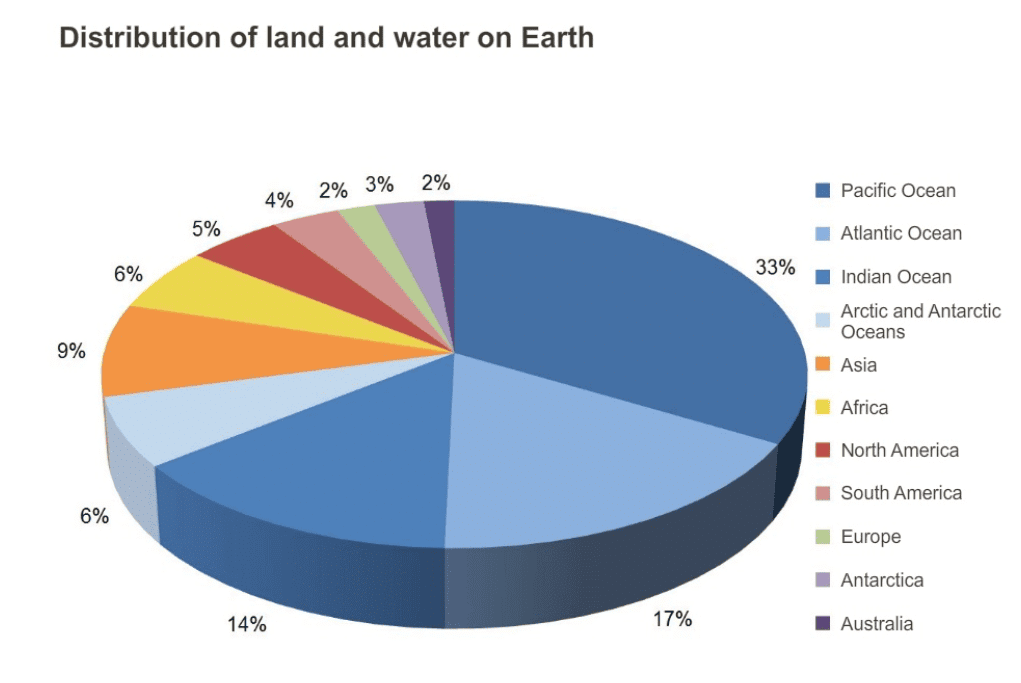 The Earth's water and land are not evenly distributed between the Northern and Southern Hemispheres.
The Earth's water and land are not evenly distributed between the Northern and Southern Hemispheres.
- Northern Hemisphere: This part of Earth has more land compared to water.
- Southern Hemisphere: This part has more water than land.
Question for Chapter Notes: Oceans and Continents
Try yourself:Which amongst the following is NOT a waterbody?
Explanation
The correct answer is Plateau because:
- A plateau is an elevated flat area of land, not a waterbody.
- Other options like Bay, Gulf, and Sea are all types of waterbodies.
Report a problem
Understanding the Maps
The maps above provide a view of the Earth from above the North Pole and the South Pole. In these maps, the blue areas represent the oceans, which also include smaller water bodies like seas, bays, and gulfs.
- Oceans: The vast bodies of saltwater that cover most of the Earth's surface.
- Seas: Smaller extensions of the oceans, partially enclosed by land.
- Bays: Broad inlets of the sea where the land curves inward.
- Gulfs: Large areas of the sea partially enclosed by land, typically larger than bays.

Question for Chapter Notes: Oceans and Continents
Try yourself:
Which part of the Earth has more land compared to water?Explanation
- The Northern Hemisphere has more land compared to water.
- The Southern Hemisphere, on the other hand, has more water than land.
Report a problem
Oceans
The Five Major Oceans
- On the world map, you can see five main oceans: The Pacific Ocean, Atlantic Ocean, Indian Ocean, Arctic Ocean, and Southern (or Antarctic) Ocean.
- Even though we talk about these oceans as if they are separate, the lines that divide them on the map are just man-made. In reality, the oceans are connected, and water flows freely between them.
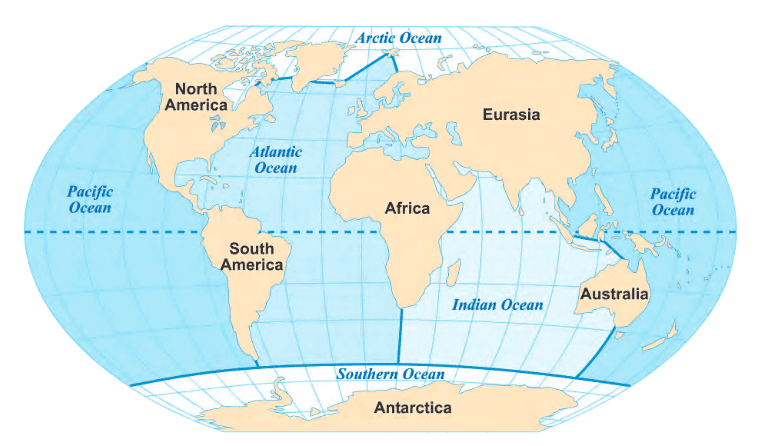 Marine Life and Biodiversity
Marine Life and Biodiversity
- The oceans are home to a wide variety of life. The plant life in the ocean, known as marine flora, includes tiny plants called algae and various seaweeds.
- The animal life, known as marine fauna, includes thousands of species such as colorful fish, dolphins, whales, and many mysterious creatures that live in the deep sea.
- Each part of the ocean, from the bright surface to the dark depths, is full of different life forms.
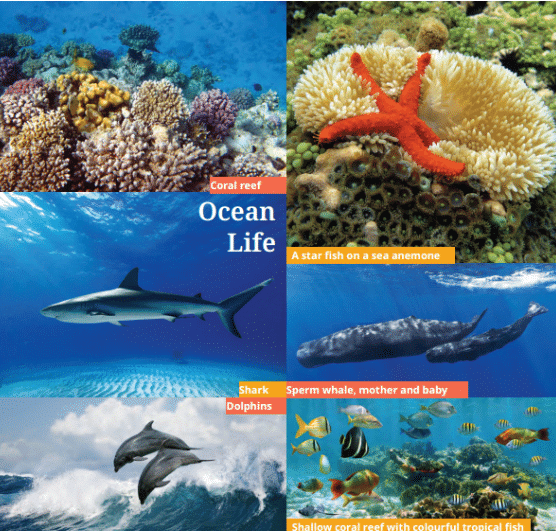
Size of the Oceans
- The Pacific Ocean is the largest of the five oceans, followed by the Atlantic Ocean.
- The Indian Ocean is the third largest, with the Southern Ocean being the fourth.
- The smallest of the five oceans is the Arctic Ocean.
Understanding the Boundaries of the Indian Ocean
- The Indian Ocean is bordered by Asia to the north, Africa to the west, and Australia to the east.
- To the south, it is connected to the Southern Ocean.
- On either side of India, there are two important parts of the Indian Ocean:
- The Arabian Sea lies to the west of India.
- The Bay of Bengal is located to the east of India.
Oceans and Disasters
Clouds and Rain
- When looking at a picture of Earth, you might notice white shapes covering parts of the globe. These are large masses of clouds.
- These clouds are responsible for bringing rain to the continents. For example, the monsoon rains in India, which are crucial for agriculture and life, originate in the ocean.
Ocean-Related Storms
- Oceans can also create powerful storms.
- These storms, like cyclones, bring heavy rain or strong winds and can cause significant damage, especially in coastal areas.
Tsunamis
- A tsunami is another dangerous natural event that begins in the ocean. It is a massive and powerful wave, usually triggered by a strong earthquake or a volcanic eruption beneath the ocean.
- Tsunamis can travel over long distances and flood coastal areas, leading to widespread destruction.
Tsunami of 2004 and Disaster Management- On 26 December 2004, a huge tsunami caused by an earthquake in Indonesia hit India and 13 other countries around the Indian Ocean. Over 200,000 people lost their lives. In India, the Andaman and Nicobar Islands, as well as the coasts of Tamil Nadu and Kerala, were badly affected.
- Tsunamis like this are rare but very destructive. Fortunately, they can often be detected before they reach the coast. Many countries, including India, work together in an 'early warning system' to help protect lives and property. India also has a 'National Disaster Management Authority' to handle such disasters and minimize damage.
More About Water Bodies
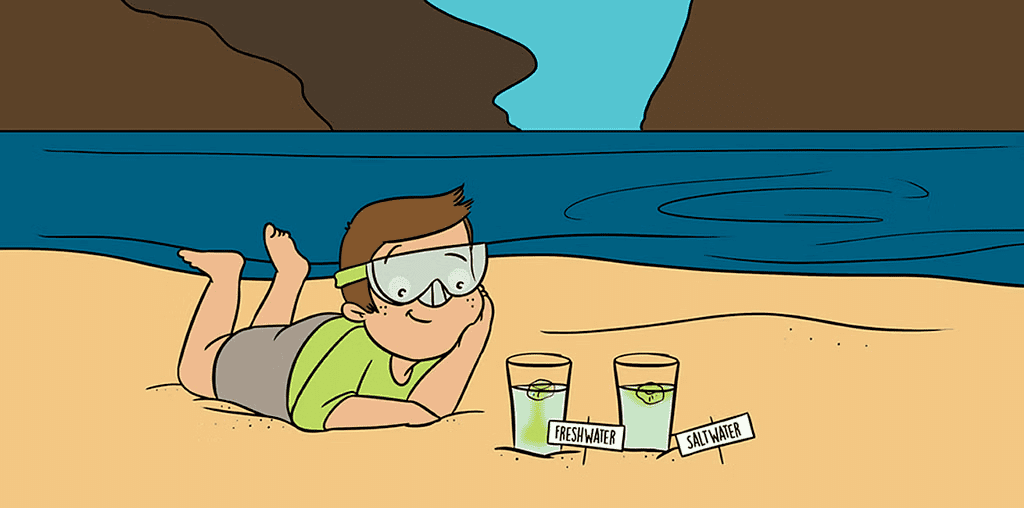
Did you ever wonder why seawater is salty? What makes it different from freshwater?
Yes, seawater is salty because it contains a lot of salt. Here’s why it’s different from freshwater:
- Salt in Seawater: Seawater has salt because rivers and rain wash salt from the land into the oceans. Over time, this salt builds up in the ocean.
- Freshwater: Freshwater, like in lakes and rivers, has much less salt. It’s mostly clean water because it hasn’t collected as much salt from the land.
So, the main difference is that seawater is salty due to all the salt that gets washed into the ocean, while freshwater has very little salt.
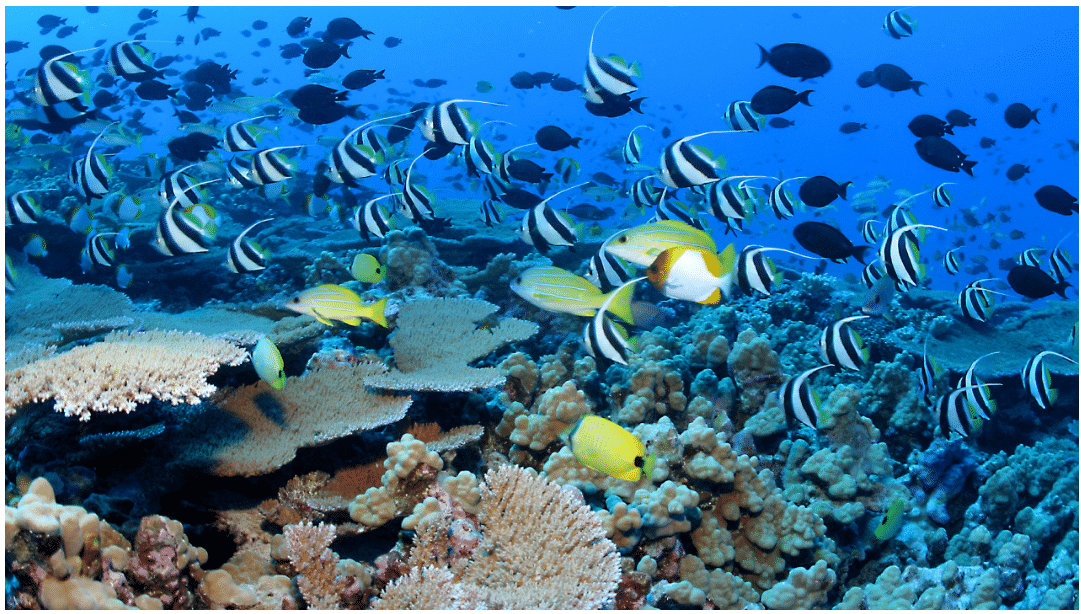
- The oceans contain the majority of the Earth's water, but this seawater is salty and cannot be used by most land animals, including humans.
- In contrast, freshwater, which is safe for drinking and other uses, makes up only a small part of the Earth's water.
- Freshwater is found in glaciers, rivers, lakes, the atmosphere, and underground, where it is known as groundwater.
Continents
Understanding Continents: Different Ways to Count
How Many Continents Are There?
When looking at a map of the oceans, you can see the continents. But counting them isn't straightforward, as the number can vary between four and seven, depending on how they are grouped.
Reasons for Different Counts
- North America and South America: Usually considered two separate continents, but they can also be seen as one single landmass.
- Europe and Asia: Although they form a single landmass, they are often seen as two continents due to their distinct historical and cultural developments. Geologists sometimes refer to them as one continent called 'Eurasia.'
- Africa and Eurasia: These are typically regarded as two separate continents, but sometimes they are counted as one.
Summary of Different Counts
- Four Continents: Africa-Eurasia, America, Antarctica, Australia.
- Five Continents: Africa, America, Antarctica, Australia, Eurasia.
- Six Continents: Africa, Antarctica, Australia, Eurasia, North America, South America.
- Seven Continents: Africa, Antarctica, Asia, Australia, Europe, North America, South America (this is the most commonly used count).
Don't Miss Out
You may have seen the five Olympic rings, one of the symbols of the Olympic Games. They symbolise the gathering of sportspeople from all over the world. The rings were chosen to represent five inhabited continents — Africa, America, Asia, Australia and Europe.
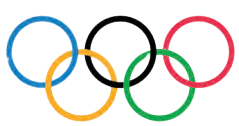
Islands
- If you’ve looked closely at the maps, you might have noticed that not all land is part of a continent. Some smaller land areas, completely surrounded by water, are called islands.
- While continents are also surrounded by water, they are much larger and therefore not considered islands. There are hundreds of thousands of islands on Earth, and they vary greatly in size.

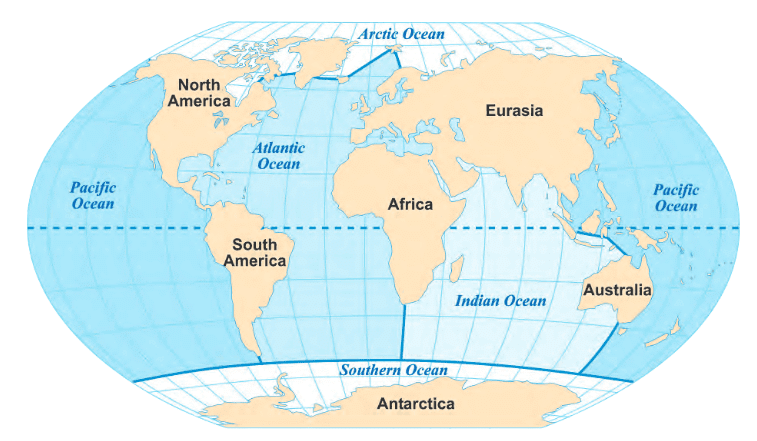
Exploring Islands and Antarctica- Greenland is the largest island in the world (you can find it on a globe or map). It’s so big that you would need to combine the areas of the 10 largest states in India to match its size.
- India has over 1,300 small islands. The two main island groups are the Andaman and Nicobar Islands in the Bay of Bengal and the Lakshadweep Islands in the Arabian Sea.
- Since 1981, India has been exploring Antarctica, a continent with an extremely cold climate. In 1983, India set up its first scientific base there, called 'Dakshin Gangotri.' Indian scientists have been researching the climate and environment in this remote region. The station where they live even has a library and a post office!
Question for Chapter Notes: Oceans and Continents
Try yourself:
What is the largest island in the world?Explanation
- Greenland is the largest island in the world, known for its vast icy landscapes and unique wildlife.
Report a problem
Oceans and Life

Role of Oceans in the Environment
- Oceans and continents are essential to our environment and influence many aspects of our lives, even if we don't always realize it.
- Oceans are a key part of the Earth's water cycle, helping to produce rainfall. Without oceans, there would be no rain, and the Earth would become a desert.
- Oceans also produce more than half of the world's oxygen through their plant life, earning them the title "the planet's lungs."
- This makes oceans crucial in regulating the climate and supporting life on Earth.
Impact of Oceans on Human History
- Oceans have had a significant influence on humanity throughout history. People have used them for migration, trade, military campaigns, and as a vital source of food through fishing.
- Coastal cultures around the world have been shaped by the sea, with many having stories and legends about the ocean, including sea gods, goddesses, monsters, and treasures. These tales reflect both the dangers and blessings of the oceans.
World Oceans Day and the Importance of Protecting Our Oceans- The United Nations has made June 8 World Oceans Day to remind us of how important the oceans are. They are like the lungs of our planet, giving us oxygen, food, and medicine, and are a vital part of Earth’s life.
- Unfortunately, human activities are polluting the oceans. We dump millions of tonnes of plastic into the water every year, harming marine life. Other types of pollution and overfishing are also damaging the ocean environment.
- It’s our shared responsibility to protect the oceans for the future of our planet and all of humanity.
Conclusion
- The Earth is covered by vast water bodies known as 'oceans' and large landmasses called 'continents.'
- Oceans are interconnected, forming a continuous body of water.
- Continents can be counted in different ways, but the most commonly accepted number is seven.
- The Northern Hemisphere contains more land than the Southern Hemisphere.
- Oceans are home to diverse marine life and play a crucial role in regulating the world's climate. However, they are currently under serious threat from human activities and require our collective efforts to protect them.



 The Earth's water and land are not evenly distributed between the Northern and Southern Hemispheres.
The Earth's water and land are not evenly distributed between the Northern and Southern Hemispheres.
 Marine Life and Biodiversity
Marine Life and Biodiversity























